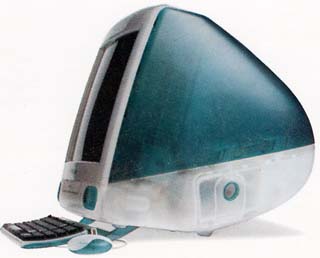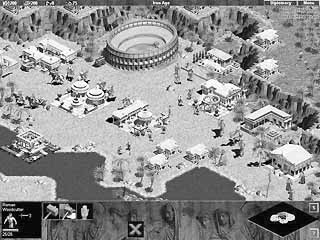Your 15 Minutes Are Up, Mr. Gates
Top Nine Cyber Stories
By Jon Lebkowsky, Fri., Jan. 8, 1999
|
|
1998 was a watershed year for computing in general and for the Internet in particular. Computers were truly acknowledged as household fixtures alongside television and telephones. Research conducted by Ovum (http://www.ovum.com), according to CyberAtlas (http://www.cyberatlas.com), "has predicted that the number of people with Internet access worldwide will quadruple by 2005. ... The market research company forecasts 206 million dial-up connections and 17.5 million permanent connections in the year 2005." The report predicts that "the U.S. Internet market will reach its saturation point by 2002." Most of the big stories in 1998 are about players dancing around positions that will set the foundation for the next century.
1. Austin became a prominent high-tech center. Speculation that this would happen fueled the boom here in the Eighties, which fell apart when the Texas economy was blown by a drop in oil prices and other more complicated stuff. A high-tech recession didn't help. However, Austin continued to be an attractive business zone, and several technology companies hung in and eventually thrived, especially Dell, which has been phenomenally successful in the Nineties. In its November 23 issue, Fortune called Austin the number one best city for business, and cited Dell as "the region's largest private employer." Austin's reputation as a hotbed of Internet action promises to pay off, too, as Net-based industries begin to thrive, such as Deja News, Acuity, Hoover's, etc. So we all got jobs, but getting to 'em through snarly traffic is the trick.
2. The Internet became a full-fledged industry. The sense of experimentation waned and the real business was under way, with millions of dollars changing hands even though the economic viability of Internet business models remained unproven. Optimism and a sense of destiny erased any remaining doubts, and the fringe aspects of Net culture gave way to a long-predicted mainstreaming effect.
3. E-commerce arrives in a big way. Consumer online commerce was finally acknowledged as a winning business model as Net-based stores like Amazon and E-Toys were gearing up for the holiday season. Existing companies (Toys R Us, Wal-Mart, The Gap) created shopping sites that showed promise, and carriers like Federal Express and United Parcel Service were seeing the impact of increased shipments resulting from online orders. People were going nuts over auction sites like Ebay, where you could still find a dadgum Furby as Christmas approached, though at something like five times its original selling price. E-commerce rode in with portalmania, in which big money was poured into the development of "portals," sites that become daily points of reference for millions of users. These sites are built around major indexes (like Yahoo) or search engines (like Excite). Netscape, in its struggle to account for lost browser market share, remade its Netcenter as a portal. Why are portals such a big deal? The best old media analogy is the television Network. If you think television Networks exist to create programming, you're confusing the means with the end. They exist to attract consumer attention, which they sell to advertisers. Portals are pretty much the same model, and if they have a shortcoming, it's one that's plagued cable-era Networks as well: how to sustain consumer loyalty in a field where there are so many choices, and how to convince advertisers that consumers are really paying attention to ads. Though the effectiveness of portals is unproven, some advertisers were willing to pay in the six or seven figures for exclusive arrangements with prominent portals like Yahoo and America Online.
4. With the Clinton scandal, the Internet arrives as multimedia news channel. When Bill Clinton's videotaped deposition was made public, the real news was that it would be "released on the Internet"; ditto the voluminous Ken Starr report. Nobody made much of other distribution channels. The Clinton video was simultaneously aired on the telly, but enough folks were watching the 2" x 1.5" RealAudio of the prez to strain global servers and bandwidth. By the end of the day, when digests of the deposition were telecast, many viewers had half-seen and half-heard the whole testimony while at work. The text of the Starr report was rushed into paperback within a few days of its release, but many had already downloaded the report and skimmed through the juicier passages.
5. The Millennium Bug. In '98, with the millennium fast approaching, "Y2K bug" doomsday scenarios started poppin' up all over the place. Awareness of the Y2K problem goes back over five years, when Peter de Jager published his article "Doomsday 2000," illuminating a programming flaw that could crash systems at the turn of the century. The problem would affect date-sensitive systems using the prolific MM/DD/YY date format. That's month, date, and year, each stored as two characters, so that 1993 is stored as "93." Not a problem 'til the century changes, and the computer doesn't know whether 00 is 1900 or 2000. Where date comparisons are a hairy big deal, as in insurance policies, banking systems, critical medical processors, etc., this confusion -- unless fixed -- could bring very bad mojo. Since information systems managers have been aware of the problem for a while, much has been done to fix critical occurrences, but there are billions of lines of code driving millions of systems, so it is unlikely we've fixed them all. De Jager writes in the January '99 issue of Scientific American that extremely optimistic or pessimistic scenarios are both as likely to be wrong. A lot of systems will be fixed, hopefully those with highest priority, but some will fail. We'll be hassled but not destroyed. His moderate view is not shared by all, however. Some analysts are stocking up on survival equipment and moving to the wilderness. Possible impact on Austin: the return of the cosmic cowboy.
6. World-making mergers. AT&T acquired Telecommunications Incorporated (TCI) in a multibillion-dollar all-stock deal. This deal had huge implications for consumers, as it pointed to a future in which telephone and cable technologies will converge within a Network infrastructure that provides high-speed access to voice, data, and programming. Netscape merged with America Online, causing shudders throughout the bastions of Net culture. Heretofore, Netscape has been the politically correct alternative to Microsoft's Internet products, and AOL has been perceived as the worst case example of mainstreaming, i.e., a proliferation of clueless Internet newbies who ignore the customs evolved by longtime denizens of cyberspace. The jury is still out on the real implications of this merger; the real plus could be that AOL subscribers get a decent browser for a change.
7. U.S. vs. Microsoft. The Justice Department's antitrust suit against Microsoft has revealed much about Microsoft's aggressive business strategies. It's been a great show, but it's not over yet. The government has more witnesses to call after the first of the year, followed by Microsoft's defense. As Wired magazine noted in "83 Reasons Why Bill Gates' Reign is Over" (in issue 6.12), this antitrust action is only one aspect of Microsoft's vulnerability. Another is the fact that a clean, efficient, useable PC operating system could threaten Microsoft's anchor, the significant penetration of its bloated, buggy Windows OS. And such an operating system does exist, sort of (see next entry).
8. Linux and the Open-Source movement prove that it might not be Bill's world after all. Linux is a competing PC operating system developed by University of Helsinki student Linus Torvald in 1991. A kind of Unix variation for small PC systems, Linux is clean and efficient, though not always easy to use. Expect that to change, though, by way of the GNOME project, which is creating a friendly graphical interface for the Linux environment. Linux and Gnome, like the products associated with Richard Stallman's Free Software Foundation, are "copyleft," which means that anyone can take the source code and modify it so long as they agree to give those modifications to the world. Projects like this are labeled "open-source," meaning that the source code for the programs is available to anyone who wants to study and modify it. The end result is that a Network of savvy programmers are building and constantly improving products, not for profit but for the good of the community of users. This attitude stems from the freewheeling research/experimentation character of the early Internet, and the fact that it has sustained despite commercialization and IPO mania makes a significant point: Greed ain't everything. In 1998 Linux was increasing its market share with commercial (Caldera, Red Hat) and freeware versions proliferating. Open-source also has corporate support: Netscape released the source code for the Communicator suite of products. Open-source Netscape developments are coordinated through the Mozilla organization (http://www.mozilla.org).
9. Internet stocks. Prices for Net-related stocks accelerated like crazy in 1998, and many Internet companies were scrambling to get their IPOs together so they could profit from the rush of unbridled enthusiasm. Investors seemed to sense that they were at the ground floor of Something Really Big, and amateur investors often don't have a clue how to assess a stock's real value, coming to the market with an uninformed optimism. John Manley, a Salomon Smith Barney strategist, was quoted by Newsweek, saying about today's market in general, that "The pros are scared to death. The amateurs are reasonably confident." Perhaps 1999 will tell whether the Internet boom has a real foundation.
TOP NINE COMPUTER ACCESSORIES
by John Avignone

1. The iMac. Not an accessory, but not quite a full-feature computer, no one really knows what to think about the iMac except for one thing: Almost everyone likes this funny-looking, transparent teal computer. It's kind of a cross between a high-performance desktop computer and the new VW Bug. It is cute, but it is also a powerful machine. Sure, there are some limitations, but if you're looking for a simple plug-in-and-use computer, check out the iMac.
2. Diamond Rio MP3 Player. Okay, so it's not really a computer accessory either, but it is still very cool. Use your computer to download MP3 files -- a near CD-quality file format -- and take them with you on this palm-sized personal stereo. The entire recording industry is up in arms over the Rio. This tiny device is causing huge headaches in weasel land. MP3 has been around for years, but has just appeared on the radar of the mega-corporate entertainment industry. You never know what's going to happen, so grab one now, while you can.
3. Personal Digital Assistant. Hand-held PDAs like the 3Com Palm series are rapidly replacing the legions of clunky Daytimers. Some models even offer wireless e-mail and Web browsing. You can't be a chic geek without a PDA.
4. DVD. Who'd want to watch a movie on their computer? You would, once you see DVD. And it's not just the full-format, crystal-clear digital sound and picture. Many titles include extra information you can turn on or off, like narration by the director. Oh, it's also a great data storage format. Stay away from DIVX DVD players, though. It's a ridiculous idea dreamed up by a couple of mega-retailers to get more of your entertainment bucks. No self-respecting nerd would touch it. Home entertainment DVD players that hook up like a VCR are also available.
5. CD-ROM Recorder. For a few hundred bucks you can make your own CD-ROMS. Some units allow you to re-record over the same rewritable blank disc thousands of times. With 600 times the capacity and hundreds of times the speed, it is time to say "adios, floppies!" Combine audio, video, graphics and text in any way you can imagine. Make mini-movies, master audio CDs, develop educational software, create interactive presentations or just send friends and family multimedia updates. You can do it all with a CDR.
6. Cable Internet Access. Time Warner is now offering cable access in Austin. Cable download speeds are 10 to 100 times faster (depending on whom you connect) than the fastest dial-up modems. Access is more expensive, but only a few bucks more than a regular account and dedicated phone line. Watch out, though. The blazing speed may cause you to lose self-control. When cable TV first came out people would spend all night staring at the screen and clicking through all of those channels. The same thing is happening with cable modems. People are staying up all night Web surfing, mesmerized by pages that load almost instantly and downloads that takes seconds, not minutes or hours.
7. Memory. Prices have finally stabilized, but at a fraction of where they were a couple of years ago. No reason not to load up. It's cheap and you can easily do it yourself. Get 64 megs for older systems and sky's the limit for newer machines. Your owner's manual will tell you what kind of memory you need and how to install it.
8. Big Hard Drives. The bigger the better. Now you can get drives close to 20 GB without selling the ranch. If you want to work with digital audio, get a SCSI drive. It's well worth the extra bucks for error-free multimedia. With a big hard drive you can do all sorts of cool multimedia stuff. You can master audio or even edit video, all digitally and fairly easily. Or you can fill it up with MP3s for your Rio. Or you can load it up with games. No matter how big the drive, people will find a way to fill it.
9. Toys! Hey, computers are fun, right? They can be with the right toys. There are all sorts of great game controllers on the market. Get a steering wheel/gear shift/pedal combo for racing games or a controller that tilts the screen when you tilt or how about a total immersion game chair for the really serious goof-off? For under $100 you can upgrade the multimedia performance of older machines. New speakers or a 3D add-on card can make a huge difference. If you haven't visited one of the big computer stores recently, it's worth the trip to see the new toys.
TOP NINE CD-ROM TITLES
by Marcel Meyer
|
|
Unlike Hollywood, in the world of interactive gaming, sequels most often yield a far superior product. For every Free Willy 3 birthed out of Los Angeles, PC players get a Star Craft: Brood War out of Irvine. Most hard-core gamers would agree, this year's crop of CD-ROM titles exceeds most of what they viewed on the silver screen. And while a sociologist might condemn the nation's top-rated games for teaching violence as the great mediator of disputes, its hard to deny the record sales of this industry of interactive escapism. From ancient civilizations, to galaxies far, far away, genius-level programmers have dreamed up a collection of worlds filled with mutated monsters, post-apocalyptic strife, and political assassinations. The bestselling titles below continue to fly off the shelf at local retailers. And with good reason.
1. Age of Empires: The Rise of Rome (Microsoft). Step back into antiquity, and let loose the dogs of war. Build armies, defend remote outposts, and pillage neighboring lands. With newly designed scythe chariots, camel riders, and slingers, along with precise battle scenarios, this expansion pack for Age of Empires simmers with all the trimmings of combat. Rise of Rome also adds four different civilizations to conquer, a mystical new soundtrack, and the opportunity to accomplish the unthinkable -- build Rome in a day.
2. Fallout 2 (Interplay). More post-apocalyptic adventure awaits. As the Chosen One, you must leave the relative safety of your tribe, cross the perilous Wastes, and discover the lost Vault 13. Armed once again with a Pip-Boy and an aged Vault Suit, you must garner experience from breaching the Cave of Trials, surviving armed conflict, and solving the devious riddles which block your path. The magnificently rendered wastelands of Fallout 2 paint so vivid a picture of war-torn destruction, the game serves a function even beyond sheer entertainment, it acts as a deterrent for nuclear war.
3. Half-Life (Valve Entertainment). Enter the underground Black Mesa Research Facility. Here a top-secret project gone terribly wrong spins your world upside down, and opens a rift into another universe. As mutant monsters spill through a tear in space-time, you must use your wits to climb upward to the light of day. Collect weapons amidst the ruins of chaos, use your best strategy against supremely intelligent monsters, and hope against hope the government doesn't eliminate all evidence of you. But as captivating as Half-Life is, the game doesn't play well on lower-end systems. However, gamers equipped with 3D-FX cards will find Half-Life full of richer colors, teeming with sound effects, and loaded with smooth, shoot-'em-up action.
4. Heretic II (Raven Software). In the intricately crafted world of Heretic II, moonlight shimmers on the darkened streets, creating an atmosphere so real, so lifelike, it is hard to separate it from reality. Monsters roam with fluid, lurking gestures, sending pulses of fear into your heart, urging you to back all the way out of your monitor. But there is no escaping this masterpiece of gaming technology. Heretic II's unparalleled design (and graphics-defying engine), is coupled with a new, inventive book of spells that burst out of your hand like exploding stars. Make a wish, and hang on for dear life. Once you step into this game, it may never let you go.
5.Lords of Magic: Special Edition (Impressions Software). Fans of real-time strategy and role-playing fantasy will undoubtedly find a perfect slow-roasted blend of wide-awake action in Lords of Magic. From the intricately textured box cover to the hand-tailored fantasy world, adventurers must complete four worthy quests and destroy the evil Lord Balkoth. Grounded in the Arthurian legends and the world of Beowulf, this mystical title drapes itself with an assortment of wandering creatures, lost artifacts, spells, and unique buildings, caves, and dungeons. All apprentice sorcerers welcome.
6. Might and Magic VI: The Mandate of Heaven (New World Computing). Those loyal to the Might and Magic series will no doubt welcome this latest edition into the tattered fray. With a countryside seemingly as large as Britannia itself, The Mandate of Heaven is a role-player's dream (or nightmare). As the leader of a small band of worthy pilgrims, it is your mission to save the royal Ironfist Dynasty. In the light of day, and the dark of night, your crew must brave darkened dungeons, fire-breathing dragons, cross angry seas, and restore balance to the land. And, with the option of real-time or turn-based combat, and hundreds of mini-quests to keep you distracted, this game is an almost impossible quest to complete.
7. Rainbow Six (Red Storm Entertainment). With Tom Clancy's name adding credibility to this real-world action game, it is no wonder this title captured all the buzz of its niche market. As the leader of a highly trained task force, it's your job to battle international terrorism and still make it home in time for dinner. Game players used to roaring into an assault with guns blazing will find an entirely different sensibility here. Attacks and assassinations are accomplished with precise calculation, but, as in the real world, targets are often taken out with a single bullet. And because this is a team-oriented contest, Internet play wondrously transforms the experience into a deadly global game of hide-and-seek.
8. Star Craft: Brood War (Blizzard Entertainment). From the ruins of the original Star Craft war arises an expansion pack truly worthy of the name Blizzard Entertainment. Centered around Kerrigan -- the Queen of Blades, Brood War adds dynamite equipment to an already explosive battle arsenal. Equip yourself with new Terran Valkyries, field Medics, and Protoss Corsairs for an even wilder ride across the stars. Also added to the mix are newly designed landscapes, including a snow-covered tundra, ready to melt under the hot fires of destruction. With a pumped-up storyline that hooks you in from page one, this expansion pack delivers even cleaner movie sequences, and more of that haunting, well-crafted space-opera music.
9. You Don't Know Jack 4: The Ride (Berkley Systems). Trivia games in the PC market tend to fall by the wayside amidst the blood-and-guts titles of the War Craft II breed, but those swanky jokesters at Berkley Systems continue to defy the odds with their bestselling You Don't Know Jack series. With a fourth installment entitled The Ride, brain teasers and trivia conundrums create a quiz party show which descends upon pop culture, attitude, and humor. As an added bonus, The Ride also includes You Don't Hear Jack, a collection of commercial parodies and music. As ridiculous as it sounds, these games really are great for parties.










